-
The BladeForums.com 2024 Traditional Knife is available! Price is $250 ea (shipped within CONUS).
Order here: https://www.bladeforums.com/help/2024-traditional/
You are using an out of date browser. It may not display this or other websites correctly.
You should upgrade or use an alternative browser.
You should upgrade or use an alternative browser.
Guardians of The Lambsfoot!
- Thread starter Jack Black
- Start date
- Joined
- Nov 30, 2016
- Messages
- 3,089
Looks like a great one Harry! As all have mentioned no brass, no verdi, no guru < oops That's Van Morrison's song.
Sorry; that looks really nice. I am thinking on a lambs foot as one of my next acquisitions. In your opinion is the firework worth the extra?
Sorry; that looks really nice. I am thinking on a lambs foot as one of my next acquisitions. In your opinion is the firework worth the extra?
Old Engineer
Gold Member
- Joined
- Nov 30, 2014
- Messages
- 10,076
Looks like a great one Harry! As all have mentioned no brass, no verdi, no guru < oops That's Van Morrison's song.
Sorry; that looks really nice. I am thinking on a lambs foot as one of my next acquisitions. In your opinion is the firework worth the extra?
Thank you very much Alan , Ron , and Chin : The back spring Filework was about 10 % extra and for me it was worth it at the time because I did not think that I might make it a User . I did not realize that it would have Steel Liners until yesterday when I was looking at them on line again . If I had known that when I ordered it , I may have not done the Filework . I am seriously considering making it a User now . I also have 2 of the TEW Barlows and I have worked back or filework , on one but not the other . I Do Not Mind at all to have a Knife that is unique or different from everybody else .
Harry
Last edited:
That is a beautiful haft! I can see what the factory meant stating that it was difficult to get horn of sufficient quality. The size of the rough ram's horn they would need to start with must be huge, to get those massive smooth sections. Certainly impressive! Well done on the workback choice as well. I think you have in this knife an ideal balance embodying the best of both aspects of knife collecting, a real working tool and a genuine work of art. A showpiece of an iconic British working knife. Nice!
- Joined
- Nov 30, 2016
- Messages
- 3,089
That is a beautiful haft! I can see what the factory meant stating that it was difficult to get horn of sufficient quality. The size of the rough ram's horn they would need to start with must be huge, to get those massive smooth sections. Certainly impressive! Well done on the workback choice as well. I think you have in this knife an ideal balance embodying the best of both aspects of knife collecting, a real working tool and a genuine work of art. A showpiece of an iconic British working knife. Nice!
The +1 what Bartleby said!
Wishing I was smarter about these subjects? Nevertheless, it's beautiful Harry.
Old Engineer
Gold Member
- Joined
- Nov 30, 2014
- Messages
- 10,076
That is a beautiful haft! I can see what the factory meant stating that it was difficult to get horn of sufficient quality. The size of the rough ram's horn they would need to start with must be huge, to get those massive smooth sections. Certainly impressive! Well done on the workback choice as well. I think you have in this knife an ideal balance embodying the best of both aspects of knife collecting, a real working tool and a genuine work of art. A showpiece of an iconic British working knife. Nice!
Thank you Sir !!! Much appreciated .
Harry
- Joined
- Jun 29, 2014
- Messages
- 1,291
It's interesting what Duncan was saying about growing to like different patterns over time. The Lambsfoot is not one of the patterns I used, or saw around when I was a kid. And the handle was a strange shape compared to what I was used to seeing.
I grew to have an interest in the pattern through reading this, and Jack's earlier Lambsfoot thread.
http://www.bladeforums.com/forums/showthread.php/1069771-The-Silence-of-The-Lambsfoot
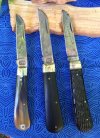
It was only recently though, that I actually acquired a couple of Lambsfoots - and was gifted one , and had a chance to use this outstanding 19th century farm and utility pattern, which has much to offer the 21st century user.
, and had a chance to use this outstanding 19th century farm and utility pattern, which has much to offer the 21st century user.
One of the things which was brought home to me, was how you just can't pre-judge what a particular knife will feel like in-hand and in-use. This effect can be observed when you get a group of knives together at the same time, and for some intangible and unpredictable reason, one of them just feels right. I would contend that most old patterns are actually quite sophisticated evolutions of human ergonomics and task/tool adaptation.
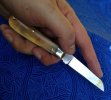
The main virtue of the Lambsfoot to me is actually the fine ergonomic shape of the swayback handle first, and then the usefulness of the straight edge in good steel and fine tip control after.
I like how this is a handle shape which still recalls its heritage: that primal, comfortable shape in hand of old, well-worn hafts of antler, or smooth, curved animal horn slabs of its cutting tool ancestors, back there in our not so distant past.
The Golden Lambsfoot
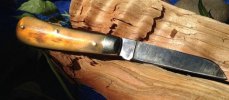
This knife has the added cool factor to me, that the haft covers actually are cattle horn. Another thing I like as a lefty, is how the golden, translucent side is the pile side, which importantly, adds to the enjoyment if Chicken-Eyeing it, while using it.


I have to start with a confession regarding this knife. I've only really been using it since this last weekend, due to it having an unusual issue which, in the end I just couldn't abide. The blade, which is centred in the channel at its tip, had actually been krinked along its length to achieve this! It was actually like someone had grabbed some pliers while the blade was annealed and first bent it one way, then a bit further down, bent it the other way. I've never seen a blade quite like that.
I can overlook minor cosmetic issues, and flaws that can be easily fixed, but not that. So I thought, what a pity, considering the outstanding handle covers, and set it aside in favour of the ebony Lambsfoot for a user.
This last weekend I was looking it over again, when I realised I could just grind down the blade flats and thin out the edge area a bit, and the worst of the rippling would be gone, and the edge apex would be reasonably reset, straight and centred.
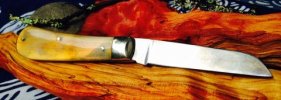
Doing this also had the benefit of providing a test in edge geometry improvement. I've noticed that a lot of the 'Golden Age' pocket knives I've been able to examine, have very thin flat grinds, almost zero grinds, compared to many modern traditionals that would tend to stick to, maybe, 0.015-0.025" behind the edge.
This would naturally make them superb cutters, and easy to sharpen, especially for people who haven't handled or seen really sharp knives before. It's easy to see how Sheffield cutlery got its reputation with fine edge design like that - aiming for high performance cutting ability first, and relying on the user to learn to work within the proper parameters of the tool, second.
I asked Stan Shaw about this, during the visit to his Kelham Island workshop Jack and I made earlier this year, and he said forgers always left some thickness near the edge to prevent blade ripple during heat treatment and cooling, and also to ensure structural uniformity and consistent hardness when material is ground away later to form the blades flats and edge apex.
The Japanese knife makers I have seen had a similar technique of forging quite thick blade blanks in the edge area, and then grinding away steel in its hardened state afterwards, to form the blade profile and edge apex.
They say it is more wearing and costly on materials and machinery, but it is the right way to do it and produces better edges. One maker I saw in Sakai, Kenichi Shiraki-san went to the additional step of having a large stock of forged blade blanks of different patterns in pigeon holes in a sort of holding area where they were stored for months before being final ground. He said it allowed the metal to 'rest' and 'season', like Finnish arms manufacturer Sako do with their rifle barrel blanks.
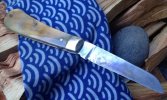
Anyway, my A. Wright and Son, Golden Ox-horn Lambsfoot reground to a blade thinness more like the Unity Lambsfoot, is a little pocket laser! I don't have my micrometer at hand - it's packed away - but the thin, flat taper from edge to spine feels pretty similar now on the Golden Lambsfoot as the hundred year old, razor edged Unity forged blade. I've used it to peel apples and slice vegies the last couple of days and it's an excellent paring knife, turning nimbly in the cut, and just gliding through material. I'm looking forward to spending more time using it over the coming months.
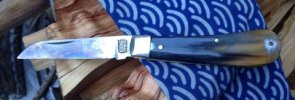
That is, if my thumb can stand it.
Let's just say The Golden Lambsfoot and the torn stump of my thumbnail are taking a break from each other at the moment.

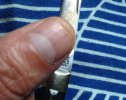
Next: Lambsfoot Noir.
I grew to have an interest in the pattern through reading this, and Jack's earlier Lambsfoot thread.
http://www.bladeforums.com/forums/showthread.php/1069771-The-Silence-of-The-Lambsfoot

It was only recently though, that I actually acquired a couple of Lambsfoots - and was gifted one
One of the things which was brought home to me, was how you just can't pre-judge what a particular knife will feel like in-hand and in-use. This effect can be observed when you get a group of knives together at the same time, and for some intangible and unpredictable reason, one of them just feels right. I would contend that most old patterns are actually quite sophisticated evolutions of human ergonomics and task/tool adaptation.

The main virtue of the Lambsfoot to me is actually the fine ergonomic shape of the swayback handle first, and then the usefulness of the straight edge in good steel and fine tip control after.
I like how this is a handle shape which still recalls its heritage: that primal, comfortable shape in hand of old, well-worn hafts of antler, or smooth, curved animal horn slabs of its cutting tool ancestors, back there in our not so distant past.
The Golden Lambsfoot

This knife has the added cool factor to me, that the haft covers actually are cattle horn. Another thing I like as a lefty, is how the golden, translucent side is the pile side, which importantly, adds to the enjoyment if Chicken-Eyeing it, while using it.
I have to start with a confession regarding this knife. I've only really been using it since this last weekend, due to it having an unusual issue which, in the end I just couldn't abide. The blade, which is centred in the channel at its tip, had actually been krinked along its length to achieve this! It was actually like someone had grabbed some pliers while the blade was annealed and first bent it one way, then a bit further down, bent it the other way. I've never seen a blade quite like that.
I can overlook minor cosmetic issues, and flaws that can be easily fixed, but not that. So I thought, what a pity, considering the outstanding handle covers, and set it aside in favour of the ebony Lambsfoot for a user.
This last weekend I was looking it over again, when I realised I could just grind down the blade flats and thin out the edge area a bit, and the worst of the rippling would be gone, and the edge apex would be reasonably reset, straight and centred.

Doing this also had the benefit of providing a test in edge geometry improvement. I've noticed that a lot of the 'Golden Age' pocket knives I've been able to examine, have very thin flat grinds, almost zero grinds, compared to many modern traditionals that would tend to stick to, maybe, 0.015-0.025" behind the edge.
This would naturally make them superb cutters, and easy to sharpen, especially for people who haven't handled or seen really sharp knives before. It's easy to see how Sheffield cutlery got its reputation with fine edge design like that - aiming for high performance cutting ability first, and relying on the user to learn to work within the proper parameters of the tool, second.
I asked Stan Shaw about this, during the visit to his Kelham Island workshop Jack and I made earlier this year, and he said forgers always left some thickness near the edge to prevent blade ripple during heat treatment and cooling, and also to ensure structural uniformity and consistent hardness when material is ground away later to form the blades flats and edge apex.
The Japanese knife makers I have seen had a similar technique of forging quite thick blade blanks in the edge area, and then grinding away steel in its hardened state afterwards, to form the blade profile and edge apex.
They say it is more wearing and costly on materials and machinery, but it is the right way to do it and produces better edges. One maker I saw in Sakai, Kenichi Shiraki-san went to the additional step of having a large stock of forged blade blanks of different patterns in pigeon holes in a sort of holding area where they were stored for months before being final ground. He said it allowed the metal to 'rest' and 'season', like Finnish arms manufacturer Sako do with their rifle barrel blanks.

Anyway, my A. Wright and Son, Golden Ox-horn Lambsfoot reground to a blade thinness more like the Unity Lambsfoot, is a little pocket laser! I don't have my micrometer at hand - it's packed away - but the thin, flat taper from edge to spine feels pretty similar now on the Golden Lambsfoot as the hundred year old, razor edged Unity forged blade. I've used it to peel apples and slice vegies the last couple of days and it's an excellent paring knife, turning nimbly in the cut, and just gliding through material. I'm looking forward to spending more time using it over the coming months.

That is, if my thumb can stand it.
Let's just say The Golden Lambsfoot and the torn stump of my thumbnail are taking a break from each other at the moment.

Next: Lambsfoot Noir.
Last edited:
- Joined
- Dec 2, 2005
- Messages
- 71,088
Thanks for yet another excellent post Chin, really great reading  I was looking at the Arthur Wright site the other day, and was reminded they actually do a 'Lefty' range, which includes a Lambsfoot. I wouldn't be surprised if they were willing to Leftify others
I was looking at the Arthur Wright site the other day, and was reminded they actually do a 'Lefty' range, which includes a Lambsfoot. I wouldn't be surprised if they were willing to Leftify others 

Last edited:
- Joined
- Jun 29, 2014
- Messages
- 1,291
Thanks for yet another excellent post Chin, really great readingI was looking at the Arthur Wright site the other day, and was reminded they actually do a 'Lefty' range, which includes a Lambsfoot. I wouldn't be surprised if they were willing to Leftify others :thumbup:
Cheers mate.:thumbup:
I do always try to select the pile side of my stag knives on the basis that that is what I'm going to be looking at.
- Joined
- Dec 2, 2005
- Messages
- 71,088
Cheers mate.:thumbup:I did notice that, but just assumed it might be reversed nail nicks. And like most left handers I've just learned to adapt - and go for pinchable blade patterns. But a true lefty traditional? With reversed blade configuration and shield (if any)? That would be worth looking into. :thumbup:
I do always try to select the pile side of my stag knives on the basis that that is what I'm going to be looking at.
I'm not actually sure, but if I get a chance to have a look, I'll check them out for you

Last edited:
Old Engineer
Gold Member
- Joined
- Nov 30, 2014
- Messages
- 10,076
Chin : : When I saw your Second Picture from the Top , it reminded me of what I noticed yesterday when I was trying get to understand my TEW Lambsfoot . And that is how the Curve of the handle just kind of curves up around the meaty heel of the thumbs when you are making a cut going away from your body . I had the Lambsfoot and a GEC 74 out while I was burning so I just tried to compare the 2 on how they were while just sharpening dried twigs . I actually thought the winner was the Lambsfoot because of that small feature for comfort and it seems like the Straight Edge of the blade will stay in the cut longer than a Clip Blade . Not a lot of science involved in that , but that is what I felt . The perceived results surprised me because I had my mind made up that I would like the way the GEC 74 Stallion worked best . I will add that both knives were As Sharpened from the respective factories . I Do Not Expect that my simple test will make me like my 72's , 73's , and 74's any less , but it did make me like the Lambsfoot a little more .
Let me give you some dimensional comparisons of the Taylors Eye Witness Lambsfoot to my 2 favorite carries . Northfield 77 Barlow Saw Cut Bone Clip Blade and Northfield 73 Stag Clip Blade . Measured with a Vernier Caliper .
Closed Length : TEW = 3.59 NF 77 = 3.69 NF 73 = 3.75
Over-All Length ; //// 6.31 //// 6.53 //// 6.90
Handle Thickness //// .67 //// .39 //// .61
Blade Spine Thickness : //// .086 //// .094 //// .094
Blade Tang Thickness //// .099 //// .094 //// .094
Opening Pull //// 3-5 //// 5-6 //// 7-8 Strictly a subjective guess
Half / Stop //// NO //// YES //// YES
Squared Off Pivot End : //// NO //// NO //// YES ( You can't use a 73 to open GEC Knife Tubes ) ( A Taylors Eye Witness Barlow is the same as a Northfield 73 )
Liners //// Steel //// Steel //// Brass
Pins //// Steel //// Steel //// Brass
Blade //// Stainless //// 1095 //// 1095
Harry
Let me give you some dimensional comparisons of the Taylors Eye Witness Lambsfoot to my 2 favorite carries . Northfield 77 Barlow Saw Cut Bone Clip Blade and Northfield 73 Stag Clip Blade . Measured with a Vernier Caliper .
Closed Length : TEW = 3.59 NF 77 = 3.69 NF 73 = 3.75
Over-All Length ; //// 6.31 //// 6.53 //// 6.90
Handle Thickness //// .67 //// .39 //// .61
Blade Spine Thickness : //// .086 //// .094 //// .094
Blade Tang Thickness //// .099 //// .094 //// .094
Opening Pull //// 3-5 //// 5-6 //// 7-8 Strictly a subjective guess
Half / Stop //// NO //// YES //// YES
Squared Off Pivot End : //// NO //// NO //// YES ( You can't use a 73 to open GEC Knife Tubes ) ( A Taylors Eye Witness Barlow is the same as a Northfield 73 )
Liners //// Steel //// Steel //// Brass
Pins //// Steel //// Steel //// Brass
Blade //// Stainless //// 1095 //// 1095
Harry
Last edited:
- Joined
- Jun 29, 2014
- Messages
- 1,291
I'm not actually sure, but if I get a chance to have a look, I'll check them out for you:thumbup:
Thanks mate, appreciate that.:thumbup: Don't put yourself out though. As I mentioned pinchable blades are a lefty's answer to a rightist traditional knife world!
Chin : : When I saw your Second Picture from the Top , it reminded me of what I noticed yesterday when I was trying get to understand my TEW Lambsfoot . And that is how the Curve of the handle just kind of curves up around the meaty heel of the thumbs when you are making a cut going away from your body . I the Lambsfoot and a GEC 74 out while I was burning so I just tried to compare the 2 on how they were while just sharpening dried twigs . I actually thought the winner was the Lambsfoot because of that small feature for comfort and it seems like the Straight Edge of the blade will stay in the cut longer than a Clip Blade . Not a lot of science involved in that , but that is what I felt . The perceived results surprised me because I had my mind made up that I would like the way the GEC 74 Stallion worked best . I will add that both knives were As Sharpened from the respective factories . I Do Not Expect that my simple test will make me like my 72's , 73's , and 74's any less , but it did make me like the Lambsfoot a little more .
Let me give you some dimensional comparisons of the Taylors Eye Witness Lambsfoot to my 2 favorite carries . Northfield 77 Barlow Saw Cut Bone Clip Blade and Northfield 73 Stag Clip Blade . Measured with a Vernier Caliper .
Closed Length : TEW = 3.59 NF 77 = 3.69 NF 73 = 3.38
Over-All Length ; //// 6.31 //// 6.53 //// 6.90
Handle Thickness //// .67 //// .39 //// .61
Blade Spine Thickness : //// .086 //// .094 //// .094
Blade Tang Thickness //// .099 //// .094 //// .094
Opening Pull //// 3-5 //// 5-6 //// 7-8 Strictly a subjective guess
Half / Stop //// NO //// YES //// YES
Squared Off Pivot End : //// NO //// NO //// YES ( You can't use a 73 to open GEC Knife Tubes ) ( The Taylors Eye Witness is the same as a Northfield 73 )
Liners //// Steel //// Steel //// Brass
Pins //// Steel //// Steel //// Brass
Blade //// Stainless //// 1095 //// 1095
Harry
Good observations there, Harry, and thanks for the data. :thumbup:
I've been pondering over the design of the comfortable back curve of the swayback handle, myself.
I intend to touch on it more in my post on the ebony Lambsfoot.
It's interesting what you found in your field test Harry - I'm a big believer in a good straight edged blade for utility work. The design allows you to transmit a lot of power down to the point, where with a bellied blade, you're kind of losing power as you come out of the cut, as you observed.
Last edited:
Campbellclanman
Platinum Member
- Joined
- Mar 10, 2007
- Messages
- 15,820
Great posts guys.
Harry - well done my friend - like our mate Jack said - you did it with style Buddy :thumbup:
:thumbup:
Chin - man..... three beauties!
Great thread Jack - you seem to have started a revolution here matey! and I thank you for that.
Harry - well done my friend - like our mate Jack said - you did it with style Buddy
Chin - man..... three beauties!
Great thread Jack - you seem to have started a revolution here matey! and I thank you for that.
Old Engineer
Gold Member
- Joined
- Nov 30, 2014
- Messages
- 10,076
Great posts guys.
Harry - well done my friend - like our mate Jack said - you did it with style Buddy:thumbup:
Chin - man..... three beauties!
Great thread Jack - you seem to have started a revolution here matey! and I thank you for that.
Thank you very much my friend . I had been wanting to get another Taylors Eye Witness . It helps a lot when the Exchange Rate is way down for me .
Harry
- Joined
- Dec 2, 2005
- Messages
- 71,088
I'm a big believer in a good straight edged blade for utility work. The design allows you to transmit a lot of power down to the point, where with a bellied blade, you're kind of losing power as you come out of the cut, as you observed.
I think a bellied blade has an advantage for dealing with game, arguably fish too, but the specialised Brusletto Fiskesprett I used to own (now gifted to PMEW) had a straight-edged blade, and we carried straight-edged blades for thousands of years, and obviously managed to deal with game and fish with them. Of the straight-edged blades, the Lambsfoot is definitely the one I find most useful, and the most versatile, though I definitely prefer a Lambsfoot with an angular point, rather than a rounded one. I find the former design makes it easier to see exactly where the point is when doing fine work, for which the Lambsfoot is superior to a Sheepsfoot. I find the design stronger than the Wharncliffe blade.
Great thread Jack - you seem to have started a revolution here matey! and I thank you for that.
Thanks pal, it's great to see people trying out the Lambsfoot, and loving it
Thank you very much my friend . I had been wanting to get another Taylors Eye Witness . It helps a lot when the Exchange Rate is way down for me .
That Exchange Rate is hitting me hard, but if I was in your position, I'd be snapping up those Sheffield knives Harry

Last edited:
- Joined
- Jun 29, 2014
- Messages
- 1,291
Chin - man..... three beauties!
Thanks, my friend. :thumbup:
I think a bellied blade has an advantage for dealing with game, arguably fish too, but the specialised Brusletto Fiskesprett I used to own (now gifted to PMEW) had a straight-edged blade, and we carried straight-edged blades for thousands of years, and obviously managed to deal with game and fish with them. Of the straight-edged blades, the Lambsfoot is definitely the one I find most useful, and the most versatile, though I definitely prefer a Lambsfoot with an angular point, rather than a rounded one. I find the former design makes it easier to see exactly where the point is when doing fine work, for which the Lambsfoot is superior to a Sheepsfoot. I find the design stronger than the Wharncliffe blade.
Yes, I think there's definitely some sound reasoning behind the theory that part of the popularity of the clip blade over a straight edged pattern in America and Australia, was due to the need to regularly do some type of skinning or game processing. This would have been a much less common task for the average person in England of the same day, where the Lambsfoot was a dominant working knife pattern.
I think I could learn to get by with a Lambsfoot (or say, an Ettrick) if that was the only pocketknife I had, for field dressing rabbits and other small game and fish. However, it's definitely not the ideal blade shape for the task, with a higher margin for error when separating tissue and avoiding the guts, due to the fine tip.
I definitely agree that the Lambsfoot has a Goldilocks porridge quality among the span of straight edged pocket knife patterns - the swayback handle, tip and the subtle handling comfort which also comes from the blade taper - are 'just right'.
I find I'm a bit more leery of where the tip is from a safety perspective, on the longer, more tapered Wharncliffe type blades.
Thanks pal, it's great to see people trying out the Lambsfoot, and loving itIf I had Meako's energy and photo skills, I'd already have a portrait of me standing in front of a Yorkshire flag wearing a beret (or perhaps more appropriately a flat-cap)!
:thumbup:
LOL!
Last edited:
- Joined
- Nov 30, 2016
- Messages
- 3,089
Thanks, my friend. :thumbup:
Yes, I think there's definitely some sound reasoning behind the theory that part of the popularity of the clip blade over a straight edged pattern in America and Australia, was the need to regularly do some type of skinning or game processing. This would have been a much less common task for the average person in England of the same day, where the Lambsfoot was a dominant working knife pattern.
I think I could learn to get by with a Lambsfoot (or say, an Ettrick) if that was the only pocketknife I had, for field dressing rabbits and other small game and fish. However, it's definitely not the ideal blade shape for the task, with a higher margin for error when separating tissue and avoiding the guts, due to the fine tip.
I definitely agree that the Lambsfoot has a Goldilocks porridge quality among the span of straight edged pocket knife patterns - the swayback handle, tip and the subtle handling comfort which also comes from the blade taper - are 'just right'.
I find I'm a bit more leery of where the tip is from a safety perspective, on the longer, more tapered Wharncliffe type blades.
LOL!:thumbup:
Nice, informative post Cambertree! I don't have a true lambsfoot, I guess? I have a couple newer American sheepfoots like the GEC speaker jack, and the TC Barlow sheepfoot. I agree with your statement about wharncliffe blades being both weaker and definitely easier to stick oneself with. It's been quite a long time since I've had to skin an animal. I suppose this helps explain my preferences[emoji849]🤙
- Joined
- Jun 29, 2014
- Messages
- 1,291

I was doing my weekly ministrations on the kitchen cutlery blades today when I realized this Zwilling Pro is near to being a lambsfoot as can be, with the slightest hint of a belly. It is quite nicely done (I especially like the shape of the choil). It's also a star in the kitchen, making quick work of thinly slicing vegetables and fruit.
It is also from the 'other' historical European steel city, Solingen. The argument for the pattern's popularity in England would seem to apply to Germany (and other European countries) as well. Any history of the Lambsfoot in Germany? (Apologies, have only made it through the first 10 pages of this thread in case this has come up already...:witless
That's interesting you bring that up, Bugdoc.:thumbup:
I have just been wondering, in light of the sleek, Ox-horn Lambsfoots effectiveness as a fruit knife and vegetable parer, what a small fixed blade knife of the same handle and blade shape would be like.
It definitely has those Lambsfoot lines - do you know what they call it?
I'm not aware of any German pocket knives with Lambsfoot-like tapered blade profiles, but there are some experts in that field who follow this thread.
I recall Jolipapa saying that the Lambsfoot style profile in France was part of some straight edge patterns called London knives, if I'm not mistaken?
Nice, informative post Cambertree! I don't have a true lambsfoot, I guess? I have a couple newer American sheepfoots like the GEC speaker jack, and the TC Barlow sheepfoot. I agree with your statement about wharncliffe blades being both weaker and definitely easier to stick oneself with. It's been quite a long time since I've had to skin an animal. I suppose this helps explain my preferences[emoji849]🤙
Thanks, my friend.:thumbup:
- Joined
- Dec 2, 2005
- Messages
- 71,088
Yes, I think there's definitely some sound reasoning behind the theory that part of the popularity of the clip blade over a straight edged pattern in America and Australia, was the need to regularly do some type of skinning or game processing. This would have been a much less common task for the average person in England of the same day, where the Lambsfoot was a dominant working knife pattern.
I think I could learn to get by with a Lambsfoot (or say, an Ettrick) if that was the only pocketknife I had, for field dressing rabbits and other small game and fish. However, it's definitely not the ideal blade shape for the task, with a higher margin for error when separating tissue and avoiding the guts, due to the fine tip.
I definitely agree that the Lambsfoot has a Goldilocks porridge quality among the span of straight edged pocket knife patterns - the swayback handle, tip and the subtle handling comfort which also comes from the blade taper - are 'just right'.
I find I'm a bit more leery of where the tip is from a safety perspective, on the longer, more tapered Wharncliffe type blades.
My granddad was from a poor background, and unemployed for a while in the Depression, so he went ferreting for rabbits and did a lot of fishing for the table. He'd eaten all sorts of things! Maybe it was then he took a liking to a clip blade, though I've always suspected his love of cowboy books might have had something to do with it!

I was doing my weekly ministrations on the kitchen cutlery blades today when I realized this Zwilling Pro is near to being a lambsfoot as can be, with the slightest hint of a belly. It is quite nicely done (I especially like the shape of the choil). It's also a star in the kitchen, making quick work of thinly slicing vegetables and fruit.
It is also from the 'other' historical European steel city, Solingen. The argument for the pattern's popularity in England would seem to apply to Germany (and other European countries) as well. Any history of the Lambsfoot in Germany? (Apologies, have only made it through the first 10 pages of this thread in case this has come up already...:witless
Very interesting Tom, thanks for posting that here :thumbup: I'm sure that'd be a great vegetable knife. I have seen German-made Lambsfoot knives, but I think they were made on contract to British retailers, and I don't know enough about German knives to say if the pattern has any history there, though I certainly don't recall ever having seen an old German Lambsfoot or a catalogue pic of one

I recall Jolipapa saying that the Lambsfoot style profile in France was part of some straight edge patterns called London knives, if I'm not mistaken?
The only French 'London' knives I've seen have had Sheepsfoot blades, but there are lots of straight-edged French patterns, and as with the German knives, my knowledge and experience is limited I'm afraid. Considering the close links between the French, German, and English cutlers, and the transfer of other designs, it'd be strange if no French or German cutler thought about the Lambsfoot pattern though. As has been noted before here, all Sheepsfoot knives will end up as a Lambsfoot, and I don't think the advantages of the Lambsfoot are easily overlooked. Of course, from what we know, the Lambsfoot appeared rather late in the day, compared to other traditional patterns.
Last edited:
